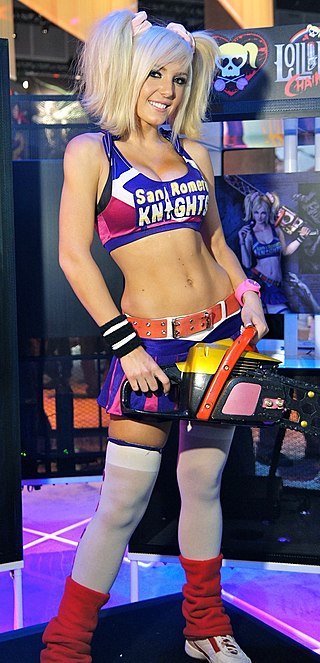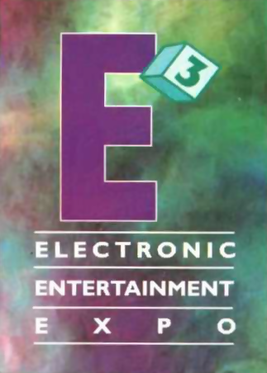
A model is a person with a role either to display commercial products or to serve as an artist's model or to pose for photography.

E3 was an annual trade event for the video game industry organized and presented by the Entertainment Software Association (ESA). It was held principally in Los Angeles from 1995 to 2019, with its final iteration held virtually in 2021. The event hosted developers, publishers, hardware manufacturers, and other industry professionals who used the occasion to introduce and advertise upcoming games, hardware, and merchandise to the press. During its existence, E3 was the world's largest and most prestigious annual gaming expo.

CES is an annual trade show organized by the Consumer Technology Association (CTA). Held in January at the Las Vegas Convention Center in Winchester, Nevada, United States, the event typically hosts presentations of new products and technologies in the consumer electronics industry.

COMDEX was a computer expo trade show held in the Las Vegas Valley of Nevada, United States, each November from 1979 to 2003. It was one of the largest computer trade shows in the world, usually second only to the German CeBIT, and one of the largest trade shows in any industry sector. COMDEX exhibitions were held in many other countries from 1982 to 2005, with 185 shows altogether. The first COMDEX was held in 1979 at the MGM Grand, with 167 exhibitors and 3904 attendees. In 1981, the first COMDEX/Spring was held in New York City.

The Entertainment Software Association (ESA) is the trade association of the video game industry in the United States. It was formed in April 1994 as the Interactive Digital Software Association (IDSA) and renamed on July 21, 2003. It is based in Washington, D.C. Most of the top publishers in the gaming world are members of the ESA.
Tokyo Game Show, commonly known as TGS, is a video game trade fair and convention held annually in September in the Makuhari Messe, in Chiba, Japan. It is presented by the Computer Entertainment Supplier's Association (CESA) and Nikkei Business Publications, Inc. The main focus of the show is on Japanese games, but some international video game developers use it to showcase upcoming releases/related hardware. The duration of the event is four days. The first two days of Tokyo Game Show are open only to industry attendees (business) and the general public can attend during the final two days.

A trade show, also known as trade fair, trade exhibition, or trade exposition, is an exhibition organized so that companies in a specific industry can showcase and demonstrate their latest products and services, meet with industry partners and customers, study activities of rivals, and examine recent market trends and opportunities.
In marketing, promotion refers to any type of marketing communication used to inform target audiences of the relative merits of a product, service, brand or issue, persuasively. It helps marketers to create a distinctive place in customers' mind, it can be either a cognitive or emotional route. The aim of promotion is to increase brand awareness, create interest, generate sales or create brand loyalty. It is one of the basic elements of the market mix, which includes the four Ps, i.e., product, price, place, and promotion.
CoverGirl is an American cosmetics brand founded in Maryland, United States, by the Noxzema Chemical Company. It was acquired by Procter & Gamble in 1989, and later acquired by Coty, Inc. in 2016. The Noxell Company advertised this cosmetics line by allowing "cover girls", models, actresses, and singers who appear on the front cover of women's magazines, to wear its products. CoverGirl primarily provides a wide variety of consumer-grade cosmetics.

The AVN Adult Entertainment Expo (AEE) is an adult entertainment convention and trade show held each January in Las Vegas, Nevada and is sponsored by AVN magazine. AEE is the largest pornography industry trade show in the United States. The 2007 AVN Expo had over 30,000 attendees, which included 355 exhibiting companies.

Driven To Perform (DTP) is an auto show billed as Western Canada's largest and most established automotive lifestyles tour and originally featured mainly import tuner sport compact cars. The inaugural show was held in Vancouver, BC in 2002 as Import Showoff Canada, but has since changed its name and expanded to include other vehicle types and into the other large metropolitan cities in this region of Canada. Major sponsors include Toyo Tires, Future Shop, Mobil1, Honda, Mazda, Lordco and Visions Electronics.

A brand ambassador is a person engaged by an organization or company to represent its brand in a positive light, helping to increase brand awareness and sales. The brand ambassador is meant to embody the corporate identity in appearance, demeanor, values and ethics. The key element of brand ambassadors is their ability to use promotional strategies that will strengthen the customer-product-service relationship, influence a large audience to buy and consume more.
Toy advertising is the promotion of toys through a variety of media. Advertising campaigns for toys have been criticized for trading on children's naivete and for turning children into premature consumers. Advertising to children is usually regulated to ensure that it meets defined standards of honesty and decency. These rules vary from country to country, with some going as far as banning all advertisements that are directed at children.
The Montreal International Games Summit (MIGS), also known as Le Sommet International du jeu de Montréal (SIJM), is a conference on video games. The first summit was held in 2004 and it usually takes place in November at Le Palais des Congrès de Montreal in Canada. Its mission is to expand the exposure of the video game community in Quebec, and to improve the Quebec video game industry. MIGS is currently the leading professional gaming summit of the East Coast. The overall aim of MIGS is to promote, train, network, and hire potential developers in the gaming industry. Professionals attending the summit partake in lectures and presentations largely oriented around how to improve specific aspects of the industry, such as art, VFX, and design. Currently, MIGS has partnered with many of the leading electronic and game development companies in Canada, including Ubisoft and Warner Bros. Games. The Montreal International Gaming Summit is networked similarly to the Electronic Entertainment Expo, using the same application to facilitate interaction between industry players and associates. In 2008 MIGS became an event that was open to the public. 2013 marked the tenth annual Montreal International Gaming Summit.

The Electronic Entertainment Expo 2009 was the 15th E3 held. The event took place at the Los Angeles Convention Center in Los Angeles, California. It began on June 2, 2009, and ended on June 4, 2009, with 41,000 total attendees.

Promotional merchandise are products branded with a logo or slogan and distributed at little or no cost to promote a brand, corporate identity, or event. Such products, which are often informally called promo products, swag, tchotchkes, or freebies, are used in marketing and sales. They are given away or sold at a loss to promote a company, corporate image, brand, or event. They are often distributed as handouts at trade shows, at conferences, on sales calls, and as bonus items in shipped orders. They are often used in guerrilla marketing campaigns.

The Electronic Entertainment Expo 2012 was the 18th E3 held. The event took place at the Los Angeles Convention Center in Los Angeles, California. It began on June 5, 2012, and ended on June 7, 2012, with 45,700 total attendees. It was televised on Spike and streamed online to computers, mobile devices, PlayStation Home and on Xbox Live via IGN's application. This was the last event to be broadcast by G4 along with being the last one to feature a physical press conference by Nintendo which mainly focused on games that were coming to the then upcoming Wii U video game console that launched later that year and was later considered to be a commercial failure.

Jessica Nigri is an American cosplayer, promotional and glamour model, YouTuber, voice actress, and fan convention interview correspondent. She has been cosplaying since 2009 and modeling since 2012, having served as an official spokesmodel for several video games and comic book series, including Lollipop Chainsaw and Assassin's Creed IV: Black Flag. She is also notable for her voice work as Cinder Fall in RWBY.

The RSA Conference is a series of IT security conferences. Approximately 45,000 people attend one of the conferences each year. It was founded in 1991 as a small cryptography conference. RSA conferences take place in the United States, Europe, Asia, and the United Arab Emirates each year. The conference also hosts educational, professional networking, and awards programs.

The Electronic Entertainment Expo 1995, commonly known as E3 1995, was the first Electronic Entertainment Expo held. The event took place at the Los Angeles Convention Center from May 11–13, 1995, with 50,000 total attendees. Highlights of the 1995 show include Sony's announcement of the PlayStation's release date and pricing, Sega's surprise launch of the Sega Saturn, and Nintendo's showcase of the Virtual Boy console.

























